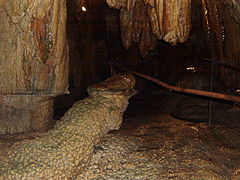JA:洞窟

|
| 説明 |
| 自然の洞窟のマッピング方法 |
| タグ |
洞窟学
洞窟は、人間が入ることができるほど大きい自然の地下の空間です(およそ5m以上の広がり)。多くの洞窟はカルスト地形にあります。
Speleology is a cross-disciplinary field that combines the knowledge of chemistry, biology, geology, physics, meteorology and cartography to develop portraits of caves as complex, evolving systems. For many nations there are cave cadastres (land registers). Most of them are measured in 3D and have a special "cave plan" or a 3d model of it.
人口洞(人工洞窟)
このページは自然に出来た洞窟についてのものです。時には人間が地下に人口の構造物を作ることがあり、これを洞窟と呼ぶことがあります。それらのタグ付けの方法として、以下のうちのいくつかが参考になるかもしれません:
historic=mineman_made=cellar_entrance- Entrance to a man made vault (e.g. cellar).- Proposed features/man made=tunnel
tourism=wine_cellarman_made=adit- Entrance to man made adit (horizontal entrance to an underground mine).横穴man_made=mineshaft- Entrance to man made shaft (vertical entrance to an underground mine).縦穴historic=tombmilitary=bunker
Protection of bats (in Europe)
In winter (around Mid of October till April) entering caves is prohibited. Bats are having winter sleep in that time. They reduce their energy expenditure down to 1%! Waking them would cause a high energy consumption, that could lead to their death.
Tagging in OSM
Cave entrances are mapped as natural=cave_entrance (see below). There is also a proposal to map the cave itself including paths etc, see bellow.
Mouth/entrance of a cave
See natural=cave_entrance
Mapping the cave
See Proposed features/natural=cave.
Previously paths in caves have been variously mapped as highway=footway (or highway=steps + tunnel=yes or tunnel=cave and/or cave=yes.
Some paths in caves are mapped in this example. discuss.
For lava tubes geological=volcanic_lava_tube has been proposed.
Cave relation
has been proposed as part of Proposed features/natural=cave, some mappers think it is sufficient to indicate a relation with cave:ref or variants.
識別番号と変化形
cave:ref=* can be used to hold an official identifier. Because such identifiers are typically valid statewide or issued by private organisations variations such as cave:ref:es:CEA=... can be used for a Spanish cave with an id issued by the CEA club. It could also happen that one cave has several cave:ref type identifiers.
cave:ref and variants can be also used to relate together unconnected features belonging to a single cave, however a relation has also been proposed for this and other purposes, see Proposed features/natural=cave
Some ideas
cave:equipment=*(none|light|helmet|climbing_gear)cave:features=*(stalactites|cave-paintings|corpses|…)cave:depth=###(maximum depth)cave:length=####(measured total entire length)cave:difficulty=*(tourist|easy|climbing_gear|dangerous)- tourist for developed caves with regular guided tours
- easy for undeveloped caves which are safely accessible without equipment other than light
- equipment when specialized equipment is necessary, or there are moderately dangerous places like narrow points dangerous when special hazards (e.g. flooding, very branched) are present
cave:size=*(small|medium|large)- small when there's a single hall or passage
- medium when there are several halls or branching passages
- large when it's bigger than medium. :-)
Note: depth and length are useful, but often not known. So the rougher size Tag could be used to specify what to expect.
Ideas that probably should not be used as they are solved by generic tags:
cave:access=*(yes|no|key|permissive|…)cave:fee=*cave:passage=*(yes|no|horse|expert_only|…)
地図記号
洞窟の一覧
- Caves all over the world
- Caves by country
- caves by continent (german)
- caves in Europe (german)
- Caves in the US
- Caves in Australia
- Show caves




